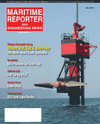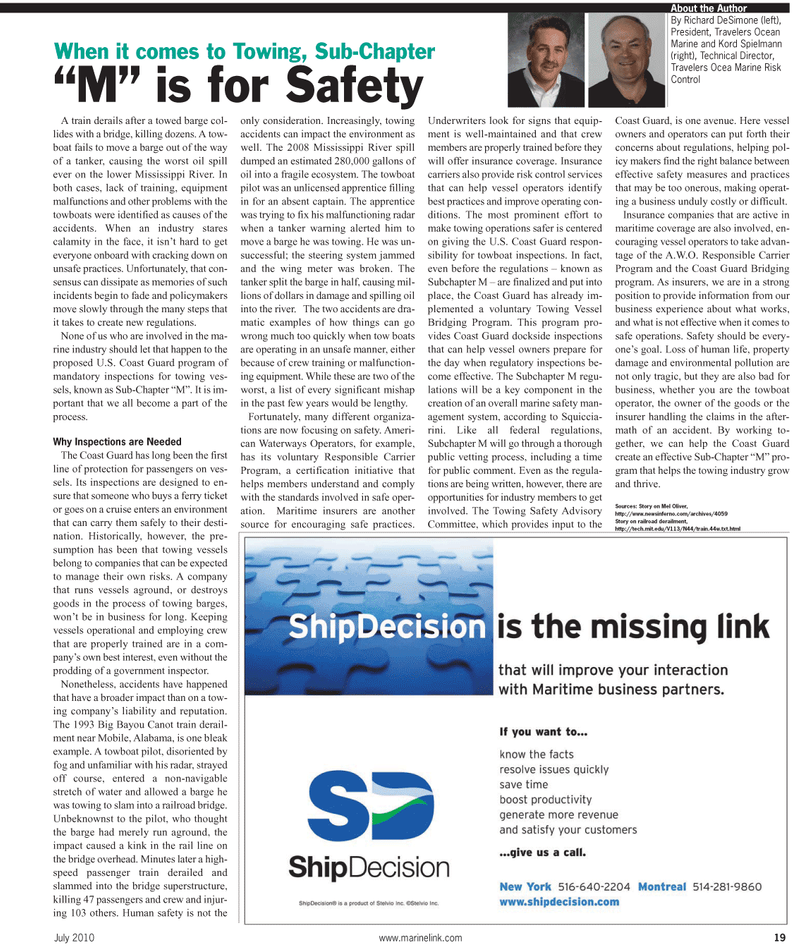
Page 19: of Maritime Reporter Magazine (July 2010)
Satellite Communication Edition
Read this page in Pdf, Flash or Html5 edition of July 2010 Maritime Reporter Magazine
July 2010 www.marinelink.com 19
A train derails after a towed barge col- lides with a bridge, killing dozens. A tow- boat fails to move a barge out of the way of a tanker, causing the worst oil spill ever on the lower Mississippi River. In both cases, lack of training, equipment malfunctions and other problems with the towboats were identified as causes of the accidents. When an industry stares calamity in the face, it isn’t hard to get everyone onboard with cracking down on unsafe practices. Unfortunately, that con- sensus can dissipate as memories of such incidents begin to fade and policymakers move slowly through the many steps that it takes to create new regulations.
None of us who are involved in the ma- rine industry should let that happen to the proposed U.S. Coast Guard program of mandatory inspections for towing ves- sels, known as Sub-Chapter “M”. It is im- portant that we all become a part of the process.
Why Inspections are Needed
The Coast Guard has long been the first line of protection for passengers on ves- sels. Its inspections are designed to en- sure that someone who buys a ferry ticket or goes on a cruise enters an environment that can carry them safely to their desti- nation. Historically, however, the pre- sumption has been that towing vessels belong to companies that can be expected to manage their own risks. A company that runs vessels aground, or destroys goods in the process of towing barges, won’t be in business for long. Keeping vessels operational and employing crew that are properly trained are in a com- pany’s own best interest, even without the prodding of a government inspector.
Nonetheless, accidents have happened that have a broader impact than on a tow- ing company’s liability and reputation.
The 1993 Big Bayou Canot train derail- ment near Mobile, Alabama, is one bleak example. A towboat pilot, disoriented by fog and unfamiliar with his radar, strayed off course, entered a non-navigable stretch of water and allowed a barge he was towing to slam into a railroad bridge.
Unbeknownst to the pilot, who thought the barge had merely run aground, the impact caused a kink in the rail line on the bridge overhead. Minutes later a high- speed passenger train derailed and slammed into the bridge superstructure, killing 47 passengers and crew and injur- ing 103 others. Human safety is not the only consideration. Increasingly, towing accidents can impact the environment as well. The 2008 Mississippi River spill dumped an estimated 280,000 gallons of oil into a fragile ecosystem. The towboat pilot was an unlicensed apprentice filling in for an absent captain. The apprentice was trying to fix his malfunctioning radar when a tanker warning alerted him to move a barge he was towing. He was un- successful; the steering system jammed and the wing meter was broken. The tanker split the barge in half, causing mil- lions of dollars in damage and spilling oil into the river. The two accidents are dra- matic examples of how things can go wrong much too quickly when tow boats are operating in an unsafe manner, either because of crew training or malfunction- ing equipment. While these are two of the worst, a list of every significant mishap in the past few years would be lengthy.
Fortunately, many different organiza- tions are now focusing on safety. Ameri- can Waterways Operators, for example, has its voluntary Responsible Carrier
Program, a certification initiative that helps members understand and comply with the standards involved in safe oper- ation. Maritime insurers are another source for encouraging safe practices.
Underwriters look for signs that equip- ment is well-maintained and that crew members are properly trained before they will offer insurance coverage. Insurance carriers also provide risk control services that can help vessel operators identify best practices and improve operating con- ditions. The most prominent effort to make towing operations safer is centered on giving the U.S. Coast Guard respon- sibility for towboat inspections. In fact, even before the regulations – known as
Subchapter M – are finalized and put into place, the Coast Guard has already im- plemented a voluntary Towing Vessel
Bridging Program. This program pro- vides Coast Guard dockside inspections that can help vessel owners prepare for the day when regulatory inspections be- come effective. The Subchapter M regu- lations will be a key component in the creation of an overall marine safety man- agement system, according to Squiccia- rini. Like all federal regulations,
Subchapter M will go through a thorough public vetting process, including a time for public comment. Even as the regula- tions are being written, however, there are opportunities for industry members to get involved. The Towing Safety Advisory
Committee, which provides input to the
Coast Guard, is one avenue. Here vessel owners and operators can put forth their concerns about regulations, helping pol- icy makers find the right balance between effective safety measures and practices that may be too onerous, making operat- ing a business unduly costly or difficult.
Insurance companies that are active in maritime coverage are also involved, en- couraging vessel operators to take advan- tage of the A.W.O. Responsible Carrier
Program and the Coast Guard Bridging program. As insurers, we are in a strong position to provide information from our business experience about what works, and what is not effective when it comes to safe operations. Safety should be every- one’s goal. Loss of human life, property damage and environmental pollution are not only tragic, but they are also bad for business, whether you are the towboat operator, the owner of the goods or the insurer handling the claims in the after- math of an accident. By working to- gether, we can help the Coast Guard create an effective Sub-Chapter “M” pro- gram that helps the towing industry grow and thrive.
Sources: Story on Mel Oliver, http://www.newsinferno.com/archives/4059
Story on railroad derailment, http://tech.mit.edu/V113/N44/train.44w.txt.html
When it comes to Towing, Sub-Chapter “M” is for Safety
About the Author
By Richard DeSimone (left),
President, Travelers Ocean
Marine and Kord Spielmann (right), Technical Director,
Travelers Ocea Marine Risk
Control

 18
18

 20
20
